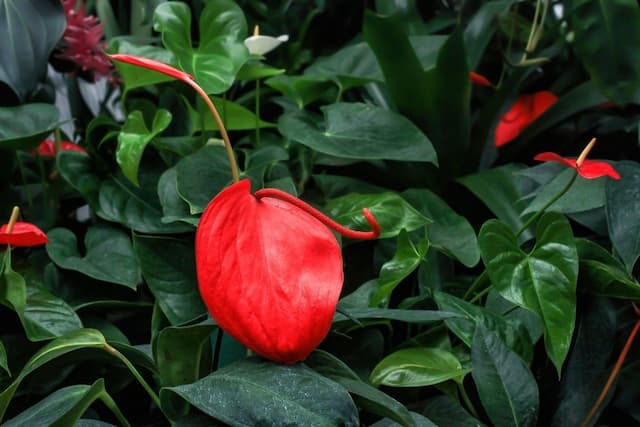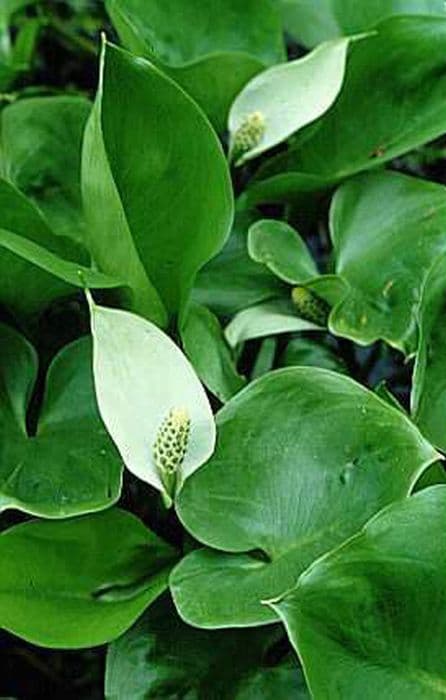Calla Lily 'Crowborough' Zantedeschia aethiopica 'Crowborough'

ABOUT
The calla lily 'Crowborough' is an elegant and distinctive plant known for its large, showy, white trumpet-shaped flowers, which are actually spathes, or modified leaves, that surround a central finger-like spadix. These blooms are crisp white and have a smooth, waxy texture, gracefully curving at the edges to create a striking display. The spadix within is a pale yellow, creating a subtle contrast against the white. The foliage of the 'Crowborough' calla lily is a rich, glossy green, forming a lush backdrop for the dramatic flowers. The leaves are large, arrow-shaped, and have a leathery feel. They often have a smooth margin and can have a slightly wavy or undulating edge, adding to the plant's visual interest. Overall, the calla lily 'Crowborough' is a plant that exudes sophistication and simplicity, making it a popular choice for gardeners who desire a touch of elegance in their garden or within floral arrangements. Its stark white flowers paired with verdant foliage create a classic beauty that is easily recognized and widely admired.
About this plant
 Names
NamesFamily
Araceae
Synonyms
Calla Lily, Arum Lily, Crowborough Arum Lily
Common names
Richardia africana, Richardia aethiopica, Zantedeschia africana, Zantedeschia aethiopica, Calla aethiopica, Colocasia aethiopica.
 Toxicity
ToxicityTo humans
Calla lily is considered poisonous due to the presence of calcium oxalate crystals, which can cause irritation and a burning sensation in the mouth and digestive tract when ingested. Symptoms of poisoning may include difficulty swallowing, nausea, vomiting, and diarrhea. Contact with the eyes can lead to irritation and possible damage.
To pets
Calla lily is toxic to pets, including dogs and cats, due to calcium oxalate crystals. Ingestion can cause symptoms such as oral irritation, excessive drooling, vomiting, and difficulty swallowing. In severe cases, ingestion may lead to dehydration, a decrease in appetite, and other gastrointestinal complications.
 Characteristics
CharacteristicsLife cycle
Perennials
Foliage type
Evergreen
Color of leaves
Green
Flower color
White
Height
2-3 feet (60-90 cm)
Spread
1-2 feet (30-60 cm)
Plant type
Herb
Hardiness zones
8
Native area
South Africa
Benefits
 General Benefits
General Benefits- Ornamental Appeal: The plant, commonly known as Calla Lily, has large, attractive white spathes and glossy green foliage that add elegance to gardens and indoor settings.
- Easy to Grow: Calla Lily is relatively easy to cultivate in various climates, adaptable to full sun or partial shade, and requires minimal maintenance.
- Water-loving: This plant thrives in damp environments, such as pond margins and bog gardens, enhancing the aesthetics of water features.
- Long Blooming Period: Calla Lily enjoys a long flowering season, often from spring through summer, providing a lengthy display of blooms.
- Cut Flowers: Its flowers are highly valued for use in floral arrangements, lasting well when cut and offering a sophisticated touch to bouquets and vases.
- Drought Tolerance: Once established, it exhibits a degree of drought tolerance, making it suitable for gardens with less frequent watering.
- Wildlife Attraction: The flowers can attract various pollinators, such as bees, which are essential for the health of the garden ecosystem.
- Versatility in Landscaping: Calla Lily can be used in a range of landscape designs, including borders, container gardens, and as focal points for their striking appearance.
- Perennial Growth: As a perennial, it will return year after year, providing a long-term investment in the garden's beauty.
 Medical Properties
Medical PropertiesThis plant is not used for medical purposes.
 Air-purifying Qualities
Air-purifying QualitiesThis plant is not specifically known for air purifying qualities.
 Other Uses
Other Uses- The calla lily, being robust and semi-aquatic, can be used in water gardens as a decorative plant, enhancing the aesthetic of the pond environment.
- In art and photography, the striking flower of the calla lily is often used as a subject for its sculptural form and as a symbol of elegance and simplicity.
- Due to its association with purity and beauty, the calla lily is commonly used in bridal bouquets and wedding decorations.
- Calla lilies are used as a natural pest deterrent; when planted in a mixed garden, they can help to keep certain pests away from other plants due to their toxicity.
- The plant can be incorporated into educational projects or science curricula to study plant biology, particularly pollination and floral structure.
- As an ornamental plant, varieties of the calla lily are used in container gardening to add a touch of sophistication to patios and indoor settings.
- In certain cultures, calla lilies are used in funerary arrangements to symbolize divine purity and the journey of the departed’s soul.
- During certain festivals or religious events, the calla lily is used for its symbolic meaning; for example, in Christianity, it's associated with the Virgin Mary and the resurrection of Jesus.
- For dye production, although not common, the pigments from calla lily flowers have the potential to be used in natural dyeing processes.
- As a cut flower, calla lilies have a relatively long vase life, making them a popular choice for floral displays in hotels, events, and corporate settings.
Interesting Facts
 Feng Shui
Feng ShuiThe Calla Lily is associated with purity and rebirth in Feng Shui. To harness these qualities, place the Calla Lily in living areas to promote a fresh and clean energetic environment, or in an area that needs an uplift in energy. Its white blossoms can also introduce a metal element, harmonizing and balancing the flow of chi in the room.
 Zodiac Sign Compitability
Zodiac Sign CompitabilityThe Calla Lily is not used in astrology practice.
 Plant Symbolism
Plant Symbolism- Beauty – Zantedeschia aethiopica 'Crowborough', commonly known as Calla Lily, is often associated with beauty due to its elegant and graceful trumpet-shaped flowers.
- Purity – The pristine white color of the Calla Lily bloom symbolizes purity and innocence, making it a popular choice for weddings and religious ceremonies.
- Faith and Purity – The Calla Lily is also commonly used in religious contexts to represent faith and purity, as its chalice-like flower resembles a goblet or vessel.
- Eternal Life – In some cultures, the Calla Lily is associated with resurrection and eternal life, perhaps due to its ability to bloom and then go dormant, only to reemerge from its bulb year after year.
- Rebirth and Prosperity – The plant's capacity for regrowth is sometimes seen as a symbol of rebirth and prosperity.
- Marital Bliss – Calla Lilies are often associated with weddings not only for their beauty but also as a wish for happiness and prosperity in marriage.
- Overcoming Challenges – The robust nature of the Calla Lily, able to thrive in diverse conditions, may represent somebody's ability to overcome challenging circumstances.
 Water
WaterThe Calla Lily should be watered regularly to keep the soil consistently moist but not soggy. Aim to water the plant thoroughly until water flows freely from the drainage holes at the bottom of its pot. During the growing season, in spring and summer, this could mean watering every few days, depending on the environment. A good rule of thumb is to provide about one gallon of water per week, but this may need to be adjusted depending on temperature and humidity. Cut back on watering in the fall and winter when the plant is dormant.
 Light
LightCalla Lily thrives best in bright, indirect sunlight. It should be placed in a location where it can receive plenty of light but is shielded from direct midday sun, which can scorch its leaves. An east or west-facing windowsill is ideal, providing the Calla Lily with the morning or afternoon sun.
 Temperature
TemperatureThe Calla Lily prefers a temperature range between 60 to 75 degrees Fahrenheit for optimal growth. It can survive in temperatures as low as 50 degrees Fahrenheit, but should not be exposed to temperatures below that, as cold temperatures can damage the plant. Avoid placing the plant in areas with drafts or sudden temperature changes.
 Pruning
PruningPruning the Calla Lily is mainly done to remove yellow or brown leaves and spent flowers to encourage healthy growth and appearance. Prune away the dead or dying material at the base of the plant using sterilized cutting tools. The best time to prune is after blooming ends or when leaves show signs of withering, which is generally in late summer or early fall.
 Cleaning
CleaningAs needed
 Soil
SoilCalla Lily 'Crowborough' thrives in rich, well-draining soil with a pH of around 6.0 to 6.5. A mix of loam, peat moss, and perlite or sand can create an ideal growing medium for this variety, providing the necessary nutrients and drainage.
 Repotting
RepottingCalla lilies should generally be repotted every two to three years to refresh the soil and accommodate root growth. Repotting is best done at the end of the dormant period, before the growing season begins.
 Humidity & Misting
Humidity & MistingCalla Lilies prefer high humidity levels, around 60-70%. They thrive when the surrounding air is moist but not excessively damp, which can promote optimal growth and flowering.
 Suitable locations
Suitable locationsIndoor
Bright, indirect light and consistent moisture.
Outdoor
Part shade, moist soil, protect from harsh sun.
Hardiness zone
8-10 USDA
 Life cycle
Life cycleThe common name for Zantedeschia aethiopica 'Crowborough' is Calla Lily 'Crowborough'. The life cycle begins with germination from seed or more typically from a rhizome, with shoots emerging in spring. The plant then enters a vegetative stage, developing large arrow-shaped leaves and eventually producing a tall flower spike enclosed in a showy white spathe. After flowering, which occurs in late spring through summer, the plant sets seed, if pollinated, within a yellow spadix at the spathe's center. In autumn, the foliage begins to yellow and die back as the plant enters dormancy. The rhizome overwinters in the soil, ready to initiate the next growth cycle when temperatures rise in the following spring.
 Propogation
PropogationPropogation time
Spring to Summer
The plant commonly known as calla lily, specifically the Zantedeschia aethiopica 'Crowborough', is typically propagated through division, a process best performed in late summer after the plant has finished flowering. To propagate through division, carefully dig up the rhizome and gently separate it into smaller sections making sure that each division has at least one growth point, often referred to as an "eye". You can then plant these divisions at a depth of around 4 inches (10 centimeters) in well-draining soil. It's ideal to water the newly planted divisions thoroughly to help establish them. Over time, these divisions will develop into new, independent calla lily plants, showcasing the full beauty of their white, trumpet-shaped blooms.









